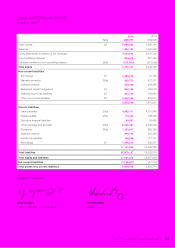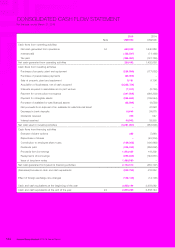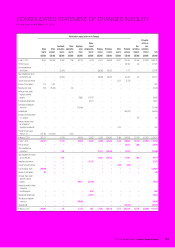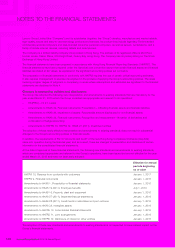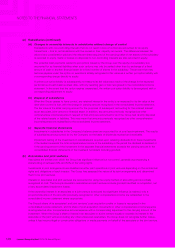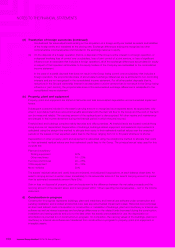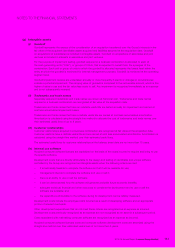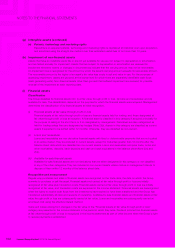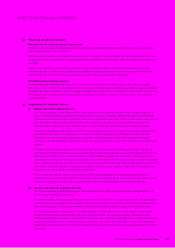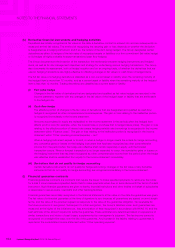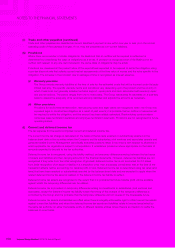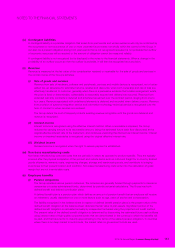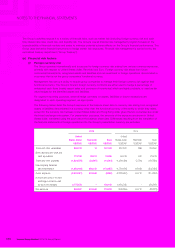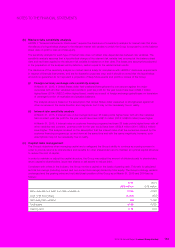Lenovo 2015 Annual Report Download - page 155
Download and view the complete annual report
Please find page 155 of the 2015 Lenovo annual report below. You can navigate through the pages in the report by either clicking on the pages listed below, or by using the keyword search tool below to find specific information within the annual report.
153
2014/15 Annual Report Lenovo Group Limited
NOTES TO THE FINANCIAL STATEMENTS
2 SIGNIFICANT ACCOUNTING POLICIES (continued)
(i) Financial assets (continued)
Recognition and measurement (continued)
Changes in the fair value of monetary and non-monetary securities classified as available-for-sale are recognized as
other comprehensive income/expense.
When securities classified as available-for-sale are sold or impaired, the accumulated fair value adjustments previously
recognized as other comprehensive income/expense are reclassified to the income statement as gains or losses from
securities.
Interest on available-for-sale securities calculated using the effective interest method is recognized in the income
statement as part of other income. Dividends on available-for-sale equity instruments are recognized in the income
statement as part of other income when the Group’s right to receive payments is established.
Offsetting financial instruments
Financial assets and liabilities are offset and the net amount reported in the balance sheet when there is a legally
enforceable right to offset the recognized amounts and there is an intention to settle on a net basis or realize the asset
and settle the liability simultaneously. The legally enforceable right must not be contingent on future events and must be
enforceable in the normal course of business and in the event of default, insolvency or bankruptcy of the company or
the counterparty
(j) Impairment of financial assets
(i) Assets carried at amortized cost
The Group assesses at each balance sheet date whether there is objective evidence that a financial asset or a
group of financial assets is impaired. A financial asset or a group of financial assets is impaired and impairment
losses are incurred only if there is objective evidence of impairment as a result of one or more events that occurred
after the initial recognition of the asset (a ‘loss event’) and that loss event (or events) has an impact on the
estimated future cash flows of the financial asset or group of financial assets that can be reliably estimated.
Evidence of impairment may include indications that the debtors or a group of debtors is experiencing significant
financial difficulty, default or delinquency in interest or principal payments, the probability that they will enter
bankruptcy or other financial reorganization, and where observable data indicate that there is a measurable
decrease in the estimated future cash flows, such as changes in arrears or economic conditions that correlate with
defaults.
For loans and receivables category, the amount of the loss is measured as the difference between the asset’s
carrying amount and the present value of estimated future cash flows (excluding future credit losses that have not
been incurred) discounted at the financial asset’s original effective interest rate. The asset’s carrying amount is
reduced and the amount of the loss is recognized in the income statement. If a loan or held-to-maturity investment
has a variable interest rate, the discount rate for measuring any impairment loss is the current effective interest rate
determined under the contract. As a practical expedient, the Group may measure impairment on the basis of an
instrument’s fair value using an observable market price.
If, in a subsequent period, the amount of the impairment loss decreases and the decrease can be related
objectively to an event occurring after the impairment was recognized (such as improvement in the debtor’s credit
rating), the reversal of the previously recognized impairment loss is recognized in the income statement.
(ii) Assets classified as available-for-sale
The Group assesses at each balance sheet date whether there is objective evidence that a financial asset or a
group of financial assets is impaired.
For debt securities, the Group uses the criteria referred to in (i) above. If, in a subsequent period, the fair value of
a debt instrument increases and the increase can be objectively related to an event occurring after the impairment
loss was recognized in the income statement, the impairment loss is reversed through the income statement.
For equity investments, a significant or prolonged decline in the fair value of the security below its cost is also
evidence that the assets are impaired. If any such evidence exists, the cumulative losses, measured as the
difference between the acquisition cost and the current fair value, less any impairment loss on that financial asset
previously recognized in the income statement, is removed from equity and recognized in the income statement.
Impairment losses recognized in the income statement on equity instruments are not reversed through the income
statement.


